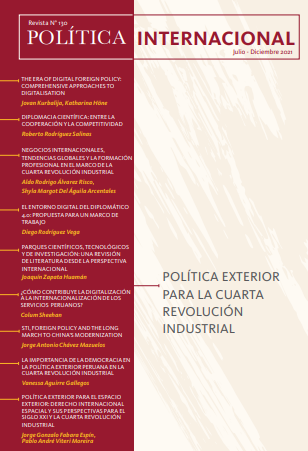Science diplomacy: between cooperation and competitiveness
DOI:
https://doi.org/10.61249/pi.vi130.26Keywords:
science diplomacy, foreign policy, scientific cooperation, pandemicAbstract
Science diplomacy is a foreign policy tool that has gained much relevance from opportunities such as 5G technology, but also from global threats, namely climate change and the pandemic. This work aims to analyze the advancements on science diplomacy in Global North and South countries, from two differentiated approaches: cooperation and competitiveness. It is argued that states participate in scientific cooperation, especially when facing major problems that could affect the entire international community. Furthermore, science diplomacy is used for enhancing a country’s competitiveness in the technological and energetic race.
Downloads
References
ACTAccelerator (2021). What is the Access to COVID-19 Tools (ACT) Accelerator, how is it structured and how does it work? https://www.who.int/publications/m/item/what-is-theaccess-to-covid-19-tools-(act)-accelerator-how-is-it-structured-and-how-does-it-work
Colglazier, E.W., Told, M., Yilla, M., Garay, J., Fernandez, G. (2021). COVID-19 as a Revelation: Challenges in Global Health Diplomacy & Disaster Diplomacy. Science Diplomacy. https://www.sciencediplomacy.org/perspective/2021/covid-19-revelation-challengesin-global-health-diplomacy-disaster-diplomacy
Consejo de Ciencia, Tecnología e Innovación Tecnológica-Concytec (2019). Perú y China acuerdan potenciar ciencia y tecnología en energías renovables, agroindustria, biodiversidad, TICs, Salud, entre otros. https://portal.concytec.gob.pe/index.php/noticias/1814-peru-y-china-acuerdanpotenciar-ciencia-y-tecnologia-en-energias-renovables-agroindustria-biodiversidadtics-salud-entre-otros
CSIS Working Group on Trust and Security in 5G Networks (2019). Criteria for Security and Trust in Telecommunications Networks and Services. Center for Strategic & International Studies. https://csis-website-prod.s3.amazonaws.com/s3fs-public/publication/200511_Lewis_5G_v3.pdf
Embajada del Japón en Perú (2021). La Cooperación Japonesa en el Perú. https://www.pe.emb-japan.go.jp/itpr_es/00_000298.html
European Commission (2020). International Cooperation on 5G. European CommissionShaping Europa’s Digital Future. https://wayback.archive-it.org/12090/20210729005605/https://ec.europa.eu/digital-single-market/en/5G-international-cooperation
Fedoroff, N. (2009). Science Diplomacy in the 21st Century. Cell, 136 (1), 9-11.
Ferguson, C. D., Abrams, M. A., Ahearne, J. F., Benedict, K., Blair, C. P., Drell, S. D., Franz, D. R., Ferguson, C. D., Garwin, R. L., Koonin, S., Kristensen, H. M., Norris, R. S., Ovshinsky, S., Schroeder, M., & Walker, P. (2012). Science Diplomacy, Science Partnerships, and U.S. National Security. Recommendations to Prevent Catastrophic Threats.http://www.jstor.org/stable/resrep18924.16
Flink, T., & Schreiterer, U. (2010). Science diplomacy at the intersection of S&T policies and foreign affairs: Toward a typology of national approaches. Science and Public Policy,37. https://doi.org/10.3152/030234210X12778118264530
FP Analytics. (2021, 16 febrero). Semiconductors and the U.S.-China Innovation Race. Foreign Policy. https://foreignpolicy.com/2021/02/16/semiconductors-us-china-taiwantechnology-innovation-competition/
Freeman, D. (2019). China and Science Diplomacy: An Emerging or a Marginal Policy?
Gadamer, H.-G. (1966). Notes on Planning for the Future. Daedalus, 95(2), 572–589. http://www.jstor.org/stable/20026985
Gast, A. (Marzo, 2012). From Cold War to Warm Relations: Fertile Ground for Science Diplomacy in Central Asia,” Science & Diplomacy, 1(1). http://www.sciencediplomacy.org/perspective/2012/from-cold-war-to-warm-relations.
Ghosh, P. (2021, 7 abril). Norway’s Sovereign Wealth Fund Makes First Investment In Renewable Energy Infrastructure. Forbes. https://www.forbes.com/sites/palashghosh/2021/04/07/norways-sovereign-wealth-fund-makes-first-investment-in-renewable-energyinfrastructure/?sh=52ce16673f6d
Gluckman, P.D., Turekian, V., Grimes, R.W., Kishi, T. (Diciembre, 2017) “Science Diplomacy: A Pragmatic Perspective from the Inside,” Science & Diplomacy, 6(4). http:// www.sciencediplomacy.org/article/2018/pragmatic-perspective
GreyB (2020, 4 junio). 5G Companies: 12 Players are leading the Research. https://www.greyb.com/5g-companies/
Hormats, R. (Marzo, 2012) “Science Diplomacy and Twenty-First Century Statecraft,” Science & Diplomacy, 1(1). http://www.sciencediplomacy.org/perspective/2012/ sciencediplomacy-and-twenty-first-century-statecraft.
Jacobsen, L. L., & Olšáková, D. (2020). Diplomats in Science Diplomacy: Promoting Scientific and Technological Collaboration in International Relations**. Berichte Zur Wissenschaftsgeschichte, 43(4), 465–472. https://doi.org/https://doi.org/10.1002/bewi.202080402
Kiernan, S., Tohme, S., Shanks, K., & Rosenbaum, B. (2021, 4 junio). The Politics of Vaccine Donation and Diplomacy | Think Global Health. Council on Foreign Relations. https://www.thinkglobalhealth.org/article/politics-vaccine-donation-and-diplomacy
Liu, C., & Urpelain, J. (2021, 7 enero). Why the United States should compete with China on global clean energy finance. Brookings. https://www.brookings.edu/research/why-theunited-states-should-compete-with-china-on-global-clean-energy-finance/
Ministerio de Economía y Finanzas (2016). Perú se consolida como mayor receptor decooperación japonesa en América Latina. https://www.mef.gob.pe/es/?option=com_content&language=es-ES&Itemid=101108&view=article&catid=100&id=2971&lang=es-ES
Panel Intergubernamental sobre Cambio Climático (2021). Summary for Policymakers.https://www.ipcc.ch/report/ar6/wg1/downloads/report/IPCC_AR6_WGI_SPM.pd
Pardikar, R. (2020, 24 septiembre). The G20 Is Investing in Fossil Fuels. Eos. https://eos.org/articles/the-g20-is-investing-in-fossil-fuels
Poo, M. (2019). International exchange and collaboration in science. National Science Review, 6(6), 1063. https://doi.org/10.1093/nsr/nwz150
Radunovic, V. (DiploFoundation 2020, 13 julio. WebDebate #31) Technology and diplomacy: Unpacking the relationship (2019) Vídeo. YouTube. https://www.youtube.com/watch?v=p1fbz8-0TOI&t=864s
Ruffini, P.B. (2018). The Intergovernmental Panel on Climate Change and the ScienceDiplomacy Nexus. Global Policy, 9(S3), 73–77. https://doi.org/https://doi.org/10.1111/1758-5899.12588
S4D4C (2019). The Madrid Declaration on Science Diplomacy. Madrid: S4D4C. https://www.s4d4c.eu/s4d4c-1st-global-meeting/the-madrid-declaration-on-sciencediplomacy/
Sabzalieva, E., Sá, C. M., Martinez, M., & Kachynska, N. (2021). Science Diplomacy Policy Processes in Comparative Perspective: The Use of Scientific Cooperation Agreements in Canada, India, Norway, and the UK. En Minerva (Londres Vol. 59, Ed. 2, pp. 149–172).SPRINGER. https://doi.org/10.1007/s11024-020-09429-y
Sacks, D. (2021, 29 marzo). China’s Huawei is winning the 5G race. Here’s what the United States should do to respond. Council on Foreign Relations. https://www.cfr.org/blog/china-huawei-5g
Shackley, S. (1997) ‘The Intergovernmental Panel on Climate Change: Consensual knowledge and Global Politics’, Global Environmental Change, 7(1), pp. 77–79.
The Royal Society (2010). New frontiers in science diplomacy. https://royalsociety.org/~/media/royal_society_content/policy/publications/2010/4294969468.pdf
Turekian, V. (2018). The Evolution of Science Diplomacy. Global Policy, 9 (3). Doi:10.1111/1758- 5899.12622.
U.S. Department of State. (2021, 17 enero). The Clean Network. United States Department of State. https://2017-2021.state.gov/the-clean-network/index.html
Wang, Z. (1999). U.S.-China Scientific Exchange: A Case Study of State-Sponsored Scientific Internationalism during the Cold War and Beyond. Historical Studies in the Physical and Biological Sciences, 30(1), 249–277. https://doi.org/10.2307/27757826
Downloads
Published
How to Cite
Issue
Section
License
Copyright (c) 2023 Roberto Rodríguez Salinas

This work is licensed under a Creative Commons Attribution 4.0 International License.








